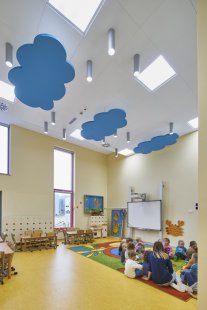
Good acoustics is half health
Noise is a part of everyday life in bustling cities, especially where large numbers of people converge. The overall level of noise has demonstrable effects on people's behavior and their mental and physical well-being. Overall, noise adversely affects the quality of our lives. Therefore, designing acoustically comfortable interiors should be a priority.
Research has shown that poor acoustics have a detrimental effect on students in schools who do not understand what teachers are saying. Office workers experience a decrease in their work efficiency and concentration ability, while reducing noise in hospitals is crucial for patients' recovery. For example, in retail, improving acoustic properties can lead to an increase in sales by up to 5-10% [1]. And this is just a brief list of examples where acoustics affect the environment we live in.
Another parameter is sound pressure level, which is the intensity of sound (noise) measured in decibels. It depends on the power of the source, the arrangement of the room, and the quantity and quality of absorbing materials.
We also assess speech intelligibility, which defines the level at which spoken words are audible and clearly understood in the interior. The last parameter of interest is sound insulation of adjoining rooms, which represents the ability of a structure to isolate sound that travels through the air or construction elements.
Stone wool ceilings give you the opportunity to acoustically address almost any space. Most ROCKFON products absorb or diffuse sound by 90%, making them often the only acoustic solution in interiors with heavy surface materials (glass, steel, flooring).
ROCKFON ceilings offer very high sound absorption primarily for the frequency of human speech, thus eliminating the so-called "Friendly Meeting Effect," where freely conversing people in one room speak progressively louder until they basically shout.
More about the acoustic properties of materials can be found at www.rockfon.cz
[1] Julian Treasuer, Sound Business, 2007
 |
Impact on Learning, Work, and Healing Efficiency
Schools, offices, hospitals, and many other places are where great emphasis is placed on acoustic comfort. Here, we encounter a high level of noise produced by a large number of people coming together.Research has shown that poor acoustics have a detrimental effect on students in schools who do not understand what teachers are saying. Office workers experience a decrease in their work efficiency and concentration ability, while reducing noise in hospitals is crucial for patients' recovery. For example, in retail, improving acoustic properties can lead to an increase in sales by up to 5-10% [1]. And this is just a brief list of examples where acoustics affect the environment we live in.
 |
How is Room Acoustics Determined?
The most important parameter is reverberation time. It is defined as the duration of reverberation when the sound pressure level drops by 60 dB from the moment the sound signal transmission ends. In most cases, the shorter the reverberation time, the better the acoustics in the room (optimal values are between 0.4 to 0.5 seconds).Another parameter is sound pressure level, which is the intensity of sound (noise) measured in decibels. It depends on the power of the source, the arrangement of the room, and the quantity and quality of absorbing materials.
We also assess speech intelligibility, which defines the level at which spoken words are audible and clearly understood in the interior. The last parameter of interest is sound insulation of adjoining rooms, which represents the ability of a structure to isolate sound that travels through the air or construction elements.
 |
Stone Wool Insulates and Absorbs
Stone wool is the ideal material functioning as an acoustic absorber that absorbs noise and ensures acoustic comfort and interior well-being. ROCKFON ceilings have excellent acoustic properties thanks to it. In this case, not only excellent sound absorption is important, but also very good sound insulation, which prevents sound from passing through the ceiling and particularly its further propagation into the surroundings.Stone wool ceilings give you the opportunity to acoustically address almost any space. Most ROCKFON products absorb or diffuse sound by 90%, making them often the only acoustic solution in interiors with heavy surface materials (glass, steel, flooring).
ROCKFON ceilings offer very high sound absorption primarily for the frequency of human speech, thus eliminating the so-called "Friendly Meeting Effect," where freely conversing people in one room speak progressively louder until they basically shout.
A Wide Range of Solutions
Acoustic experts today can solve most noise issues. In many cases, an acoustic suspended ceiling is the best solution. In other, more challenging situations, acoustic wall panels, partitions, freely suspended absorbers, or other acoustic elements can be installed additionally. The ideal situation is when the necessary measures are implemented in the initial phase of construction.More about the acoustic properties of materials can be found at www.rockfon.cz
[1] Julian Treasuer, Sound Business, 2007
The English translation is powered by AI tool. Switch to Czech to view the original text source.




0 comments
add comment
Related articles
0
15.03.2022 | Messner's museum offers a monolithic surface and great acoustics
0
21.05.2018 | Creating the Perfect Office – Why Acoustics Matter So Much
0
24.01.2018 | For less noise in schools
0
11.09.2017 | New ceilings in older houses
0
07.11.2016 | New ceilings with Scandinavian design
0
22.09.2016 | Ceilings for Healthcare Facilities
0
12.07.2016 | The beauty of monolithic ceilings











